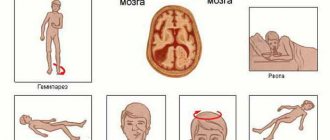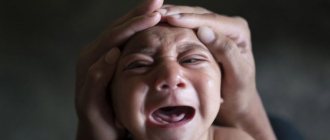Today we will talk about something that, unfortunately, often happens in children in the first year of life - traumatic brain injuries. For children, the most traumatic ages are considered to be 3 - 4 months, 1 - 1.5 years, 7 - 10 years. From 3 to 4 months, the baby masters turning over from his stomach to his back, his first independent change in body position in space. At the age of about 1 year, the baby learns to walk, but often loses its balance, hitting objects and falling. The age from 7 to 10 years marks the beginning of a child’s independent social life, when he goes to school, for a walk, etc., unaccompanied by adults.
As already mentioned, from 3 to 4 months the child masters turning over from back to stomach. Before starting to roll over, the baby trains, turns first on one side, then on the other, throws his leg, grunts, trying to turn over, and at some point turns over.
As a rule, such a metamorphosis is unexpected for adults caring for the baby, because they have managed to get used to the image of the child obediently lying on his back. This is where danger awaits us. As soon as the mother gets distracted for a second, takes a step to the side, the child falls. In 9 out of 10 cases, children fall from the changing pad, and since the heaviest part of the body is the head, the fall occurs head down.
According to statistics, in infancy, about 40% of children fall from a height, but, fortunately, nature took care of the babies and endowed them with a “margin of safety” in the form of an open fontanel, soft sutures between the bones of the skull, a large intracranial space, so only 1. 5% of falls from height have serious consequences. However, as practice shows, even if everything ended well, the horror of the experience and the feeling of guilt settle in the mother’s heart for a long time.
What to do if a child falls?
Try not to panic, take the child in your arms, calm him down, call an ambulance.
According to emergency care standards, every child with a head injury should be hospitalized. This usually happens like this: an ambulance delivers the baby and his mother to the emergency room of a specialized hospital, where the neurosurgeon on duty examines the child, conducts an ultrasound examination of the brain, and x-rays of the skull bones. If the baby’s condition does not cause concern and the examination reveals nothing wrong, the mother and child can be sent home under the supervision of a neurologist at their place of residence.
If, during examination, the baby cries continuously, or, conversely, is lethargic, or there is weakness in the arm or leg and the baby cannot move them, or there was repeated vomiting, or changes were detected during ultrasound examination and x-ray, then the child remains in the hospital and receives treatment according to the degree of traumatic brain injury.
Treatment uses medications that reduce swelling of the brain tissue, improve blood flow and metabolic processes in the nervous tissue.
An intracerebral hematoma can become a serious complication of traumatic brain injury, when blood from damaged vessels pours into the cranial cavity, which inevitably leads to compression of the brain. In such a situation, urgent surgery is required to remove the hematoma.
When the child’s condition becomes stable, he is discharged home under the supervision of a neurologist.
Head injury: emergency care
Head impacts and blows to the head occur repeatedly in every child's life.
A fundamental feature of children in the first year of life is the fact that the amount of fluid in the cranial cavity is much higher than that in older children and (or) adults. In addition, the baby’s brain is not tightly closed in the cranium, since there are fontanelles, as well as pliable and movable sutures between the bones of the skull. All this creates the possibility of shock absorption and to some extent reduces the risk of impacts to the head and head.
The vast majority of head injuries end safely and are not accompanied by any serious consequences. However, any blow to the head (to the head) potentially requires serious consideration , since very dangerous damage to the brain substance and bleeding in the cranial cavity are possible.
A very common specific condition that occurs after a head injury is called concussion .
Medical science still does not know exactly what happens to the brain during a concussion. It is assumed that during an injury, the brain substance is shaken and hits the skull from the inside. As a result, connections between brain cells and its parts are disrupted. All this is accompanied by very specific symptoms, primarily disorders of consciousness. The fundamental point is that the integrity of the brain tissue is not damaged during a concussion.
A head injury may be accompanied by damage to the brain substance with the development of edema and hemorrhage. In this case, they talk about a brain contusion .
Severe swelling of the brain tissue and intracranial hematomas lead to a very dangerous condition - compression of the brain .
Shake
,
bruise
and
compression
of the brain are united by such a concept as
traumatic brain injury .
Traumatic brain injury can be closed (without violating the integrity of the bones of the skull) and open (respectively, with violating the integrity of the bones).
Between the inner surface of the skull bones and the brain matter itself is the dura mater. An open traumatic brain injury with damage to the dura mater is called penetrating .
If, as a result of the impact, only soft tissues are damaged (skin, subcutaneous tissue above
bones of the skull) and there is no disorder of consciousness, then this condition is called
head contusion .
All of the technical terms listed are medical diagnoses. The diagnosis is made by a doctor.
However, there are very clear symptoms that indicate that a head injury is potentially dangerous and requires mandatory medical attention.
The task of parents is to know these symptoms and provide emergency assistance.
Attention!
Seek medical help if following a head injury:
- disturbance of consciousness of any severity and any duration;
- speech disorders;
- inappropriate behavior;
- unusual drowsiness;
- intense headache that persists for more than one hour after the injury;
- convulsions;
- more than one episode of vomiting;
- dizziness and/or imbalance that persists for more than one hour after injury;
- inability to move an arm or leg, weakness in an arm or leg;
- pupils of different sizes;
- the appearance of dark (dark blue) spots under the eyes or behind the ears;
- bleeding from the nose or ears;
- discharge of colorless or bloody fluid from the nose or ears; After the injury, the child cried, and while crying, like all children, he sniffled. I stopped crying, but I still had a runny nose, which was not there before the injury. To the doctor!
- After an injury, hearing becomes worse or something is wrong, fog or double vision, unusual taste in the mouth, something doesn’t smell right, decreased skin sensitivity, goosebumps... See a doctor!
Regardless of the symptoms, seeking medical help is necessary if a head injury was sustained while intoxicated or under the influence of drugs.
ATTENTION!
Dangerous symptoms may not appear immediately, so parents should closely monitor their child for at least 24 hours after a head injury, even if the injury appears to be minor.
If after the injury the child calms down and falls asleep, he should be woken up every 2-3 hours and asked simple questions (what is your name?, etc.).
Once again, any head injury is potentially dangerous. The slightest doubt - see a doctor!
Emergency care for head injury
There are no dangerous symptoms:
- calm the child down;
- try your best to limit physical activity (lay down and read, avoid active games, etc.);
- Apply cold to the injured area.
If dangerous symptoms are detected:
- Assess the state of breathing and circulation, and in critical condition, begin cardiopulmonary resuscitation;
- if breathing and blood circulation are preserved, but there is no consciousness, try to keep the child in a supine position, on a hard, flat surface, support the head with your hands; Monitor breathing carefully: if breathing is difficult in this position due to vomiting or excess saliva, place the child in a stable position on his side . When turning, hold your head, trying to avoid its rotation, excessive throwing back and lateral tilt;
- while waiting for help (optimally in the supine position, even before turning to a stable lateral position), it is advisable to immobilize the cervical spine ;
- if the child is conscious, wait for help in the supine position without a pillow;
- do not give food or drink;
- Do not move the child unless absolutely necessary.
When stopping bleeding:
- follow the general rules for stopping bleeding and treating a wound ;
- at the slightest suspicion of damage to the skull bones, categorically avoid direct pressure on the wound - cover the wound with a dressing material, do not remove foreign bodies from the wound.
(This publication is a fragment of the book by E. O. Komarovsky “Handbook of Sensible Parents. Part 2. Emergency Care” adapted to the format of the article.)
What can be the consequences of injury?
In most cases, as already mentioned, infant falls end happily and do not affect the child’s development in any way. In 15% of cases, cerebrasthenic syndrome develops, when the child is often capricious, gets tired quickly, and does not gain weight and height well. This condition, without treatment, can last for several months and often causes developmental delays.
Such severe diseases as post-traumatic epilepsy, mental retardation, and cerebral palsy are formed as a result of brain injury in approximately 1.5% of cases. All patients with such a diagnosis are considered disabled; they require comprehensive rehabilitation treatment and supervision by specialists for many years, but even using the most modern treatment methods, it is not possible to completely get rid of the defect.
To avoid unpleasant consequences, do not lose your vigilance, especially if your child is approaching 3 months.
The child hit his head: damage and wounds
What to do if a child hits his head and a bleeding wound appears:
In this case, you should give him the same help as for a bruise in any other place:
- On a bleeding wound, you should first apply ice (crushed ice or a bag of frozen vegetables is best), and a little later, make a pressure bandage;
- If the head wound is more than 7 mm wide and 2 cm long, the child must be taken to a medical facility - such wounds usually require stitches.
Let us repeat: if a child hits his head and a “bump” appears at the site of the injury, or even a small bleeding wound appears, but he does not lose consciousness, then no matter how “scary” it may look from the outside, it is a serious injury. there is no reason for the head. And if the baby does not show any dangerous symptoms (we will list them below), then you don’t even have to call a doctor or take your child to the hospital.
And if still...
If an accident happens and a child falls and hits his head, the main thing is not to panic and not to find out who is to blame. All attention to the baby. Your task is to quickly find out how serious the injury is. How to do it? The easiest injury is a bruise of the soft tissues of the head (not to be confused with a brain contusion!). In this case, the brain does not suffer in any way. There may be a small abrasion or bump at the site of the impact. The child, after crying for 10-20 minutes, calms down and behaves as usual. In this case, you do not need to see a doctor. With a concussion, everything is much more serious: a short-term loss of consciousness may occur, vomiting begins (in children under 3 months - multiple times), the skin turns pale, and cold sweat appears. The child is lethargic, drowsy, refuses to eat; those who are older and capable of some information about themselves complain of headaches and tinnitus. An even more serious injury is a brain contusion. In this case, immediately after the injury, a prolonged blackout of consciousness is possible (sometimes it is absent for more than an hour). In especially severe cases, respiratory and cardiac problems occur. In case of a skull fracture , in addition to the general serious condition of the child, blood or light fluid (CSF) may leak from the nose or ear, and bruises may form around the eyes (a symptom of glasses). It is very important to know that with skull fractures, symptoms do not appear immediately, but several hours after the injury. Therefore, rule number one is that after a bruise (damage) to the head, you must monitor the child’s condition very carefully. Any doubts that “everything is okay” is a reason to immediately consult a doctor. If signs of a concussion or brain injury appear, call a doctor immediately.
First aid for head injuries
First aid for a blow to the back of the head is necessary for the victim immediately after the incident, without waiting for the ambulance to arrive. Of course, an ambulance also needs to be called, since in the future the wounded person will need professional treatment from doctors. What to do in this situation:
- Place the injured person on the floor or sofa (depending on location) so that he remains at rest.
- Apply a compress to the bruised area. This could be a frozen product from the freezer or a piece of ice wrapped in a towel; also use a bottle with cool liquid. The compress should be applied for no more than 15 minutes, then removed for half an hour and applied again.
- If the victim experiences a feeling of nausea, he must be turned on his side.
Note! You only need to do what will alleviate the condition of the wounded person, but you should not give painkillers immediately after a bruise until an ambulance arrives. This may interfere with the examination and diagnosis of the injury.








